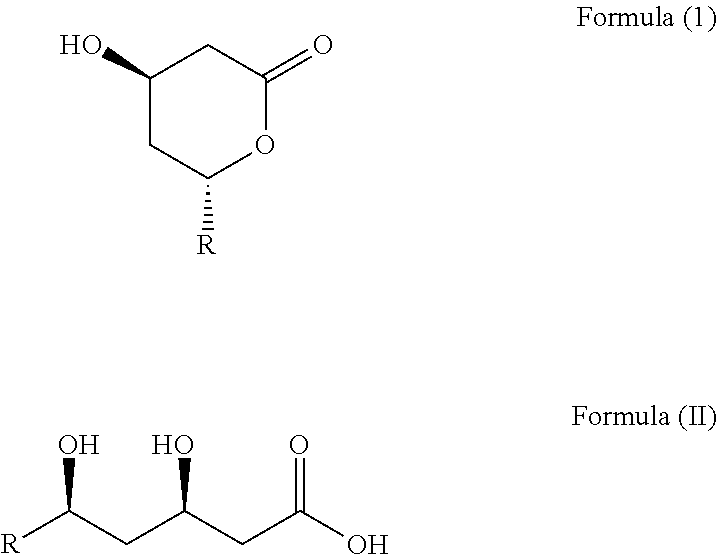Statins of Omega-3 Polyunsaturated Acids for Treating Hypercholesterolemia
a technology of omega-3 polyunsaturated acids and statins, which is applied in the field of statinized derivatives of omega3 fatty acids, and can solve problems such as side effects of statins
- Summary
- Abstract
- Description
- Claims
- Application Information
AI Technical Summary
Benefits of technology
Problems solved by technology
Method used
Image
Examples
example 1
EPA-aldehyde
[0047]
[0048]EPA ethyl ester (97%, Nutegrity, 20.0 g, 0.065 mol) was dissolved in dichloromethane (120 mL) under an argon atmosphere. The solution was cooled in acetone-dry ice batch and 1M diisobutylaluminum hydride (115 mL) in dichloromethane was added drop-wise over 1 hour. After addition, the solution stirred for 3 hours at −78° C. The reaction mixture was quenched with saturated ammonium chloride (100 mL) added drop-wise followed by 5% HCl (100 mL). Additional dichloromethane (200 mL) was added and the mixture warmed to RT. After filtration, the dichloromethane layer was separated, dried over anhydrous sodium sulfate, filtered, and concentrated. The crude EPA aldehyde (19.2 g, yellow oil) was purified by column chromatography on silica gel (250 g) eluting with ethyl acetate / heptanes (1:20) to give EPA aldehyde as a clear oil (12.9 g, 79% yield, pure by NMR) and is characterized by the following spectra:
[0049]1H NMR (300 MHz, CDCl3 / TMS): δ 9.78 (s, 1H), 5.50-5.22 (m, ...
example 2
Hytra
[0051]
[0052](S)-1,1,2-Triphenylethane-1,2-diol (Alfa Aesar, 9.5 g, 32.7 mmol) was dissolved in dichloromethane (200 mL) under an argon atmosphere. The flask was cooled in an ice-water bath, and acetyl chloride (6.0 g, 76.4 mmol) was added. Pyridine (8.0 g, 82 mmol) was added drop-wise over 5 minutes. After 2 hours, the product was filtered. The product was dissolved in dichloromethane (2 L) and extracted with 5% aqueous hydrochloric acid (150 mL) and water (150 mL). The dichloromethane solution was dried over anhydrous sodium sulfate, filtered, concentrated (to 40 mL) and stored in a freezer for two hours. The solid product was collected on a funnel, washed with dichloromethane (15 mL) and dried under high vacuum overnight. The experiment produced Hytra as a white solid (10.1 g, 93% yield) and is characterized by the following spectra:
[0053]1H NMR (300 MHz, DMSO-d6): δ 7.48 (d, 2H, J=7.5 Hz), 7.33-7.23 (m, 5H), 7.18-7.05 (m, 8H), 6.58 (s, 1H), 6.14 (s, 1H), 1.93 (s, 3H).
example 3
EPA-Hytra Condensation
[0054]
[0055]Hytra (prepared as in Example 2, 5.50 g, 16.5 mmol) was added to dry THF (100 mL) under an argon atmosphere. The slurry was cooled in a dry ice / acetone bath. LDA solution (2.5 M, 20 mL, 50 mmol) was added drop-wise over 10 minutes. The mixture was slowly warmed to −10° C. over 2 hours, and stirred further for 30-40 minutes at −10° C. The solution was cooled again to −78° C. and the EPA-aldehyde (6.56 g, 22.9 mmol) in THF (20 mL) was added drop-wise over 30 minutes. The mixture was stirred for 2 hours at −78° C. under argon. The reaction was quenched at −78° C. with a drop-wise addition of saturated ammonium chloride solution (100 mL). The solution was warmed to −5° C. and diluted with water (100 mL). The mixture was extracted twice with ethyl acetate (150 mL). The ethyl acetate extracts were combined, dried over anhydrous magnesium sulfate, filtered, and concentrated on a rotary evaporator. The crude oil (12.4 g) was purified by column chromatograph...
PUM
| Property | Measurement | Unit |
|---|---|---|
| Mass | aaaaa | aaaaa |
| Fraction | aaaaa | aaaaa |
| Mass flow rate | aaaaa | aaaaa |
Abstract
Description
Claims
Application Information
 Login to View More
Login to View More - R&D
- Intellectual Property
- Life Sciences
- Materials
- Tech Scout
- Unparalleled Data Quality
- Higher Quality Content
- 60% Fewer Hallucinations
Browse by: Latest US Patents, China's latest patents, Technical Efficacy Thesaurus, Application Domain, Technology Topic, Popular Technical Reports.
© 2025 PatSnap. All rights reserved.Legal|Privacy policy|Modern Slavery Act Transparency Statement|Sitemap|About US| Contact US: help@patsnap.com



